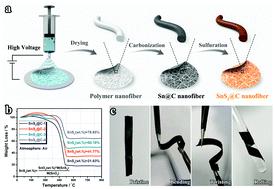当前位置:
X-MOL 学术
›
Energy Environ. Sci.
›
论文详情
Our official English website, www.x-mol.net, welcomes your
feedback! (Note: you will need to create a separate account there.)
Foldable potassium-ion batteries enabled by free-standing and flexible SnS2@C nanofibers
Energy & Environmental Science ( IF 32.4 ) Pub Date : 2020-11-23 , DOI: 10.1039/d0ee02919j Deping Li 1, 2, 3, 4, 5 , Linna Dai 2, 6, 7, 8, 9 , Xiaohua Ren 5, 10, 11, 12 , Fengjun Ji 1, 2, 3, 4, 5 , Qing Sun 2, 6, 7, 8, 9 , Yamin Zhang 2, 6, 7, 8, 9 , Lijie Ci 1, 2, 3, 4, 5
Energy & Environmental Science ( IF 32.4 ) Pub Date : 2020-11-23 , DOI: 10.1039/d0ee02919j Deping Li 1, 2, 3, 4, 5 , Linna Dai 2, 6, 7, 8, 9 , Xiaohua Ren 5, 10, 11, 12 , Fengjun Ji 1, 2, 3, 4, 5 , Qing Sun 2, 6, 7, 8, 9 , Yamin Zhang 2, 6, 7, 8, 9 , Lijie Ci 1, 2, 3, 4, 5
Affiliation

|
Potassium-ion batteries (PIBs) have been regarded as promising alternatives to lithium-ion batteries in large-scale energy storage systems owing to the high abundance and low cost of potassium. However, the large radius of the K-ion hinders the development of suitable electrode materials. In this work, we confine SnS2 in N,S co-doped carbon nanofibers as anode materials for PIBs with high reversible capacity (457.4 mA h g−1@0.05 A g−1), remarkable cycling stability (1000 cycles@2.0 A g−1), and superior rate capability (219.4 mA h g−1@5.0 A g−1), overmatching most of the reported studies. The origin of the high reversible capacity is revealed by in situ XRD techniques. The combined capacitive and diffusion-controlled behaviors are disentangled through consecutive CV measurements. Combining the Randles–Sevcik equation and dQ/dV plots, correlations between the K-ion storage behaviors and diffusion kinetics at various potassiation depths are constructed. Theoretical calculations on K adsorption affinities at various N,S co-doped sites illuminate the synergistic effects of the N,S co-doping strategy in boosting the K-ion transport kinetics. Moreover, foldable potassium-ion full cells are successfully assembled with stable cycling performance, showing application potential in flexible electronic devices. These findings will boost the rational design and mechanistic understanding of anode materials in PIBs and related energy storage devices.
中文翻译:

可折叠的钾离子电池,具有独立的,灵活的SnS2 @ C纳米纤维
由于钾的丰度高和成本低,钾离子电池(PIB)被认为是大规模储能系统中锂离子电池的有前途的替代品。然而,K离子的大半径阻碍了合适的电极材料的发展。在这项工作中,我们将SnS 2限制在N,S共掺杂碳纳米纤维中,作为具有高可逆容量(457.4 mA hg -1 @ 0.05 A g -1),显着的循环稳定性(1000次循环@ 2.0 A g )的PIB的负极材料-1)和出色的速率能力(219.4 mA hg -1 @ 5.0 A g -1),与大多数已报道的研究不符。高可逆容量的起源通过原位揭示XRD技术。通过连续的CV测量,可以解开组合的电容和扩散控制行为。结合Randles–Sevcik方程和d Q / d V绘制了在不同钾化深度下的K离子存储行为与扩散动力学之间的关系图。在各种N,S共掺杂位点上K吸附亲和力的理论计算阐明了N,S共掺杂策略在提高K离子迁移动力学方面的协同作用。此外,可折叠的钾离子全电池以稳定的循环性能成功组装,显示出在柔性电子设备中的应用潜力。这些发现将促进PIB和相关储能设备中阳极材料的合理设计和机械理解。
更新日期:2020-12-17
中文翻译:

可折叠的钾离子电池,具有独立的,灵活的SnS2 @ C纳米纤维
由于钾的丰度高和成本低,钾离子电池(PIB)被认为是大规模储能系统中锂离子电池的有前途的替代品。然而,K离子的大半径阻碍了合适的电极材料的发展。在这项工作中,我们将SnS 2限制在N,S共掺杂碳纳米纤维中,作为具有高可逆容量(457.4 mA hg -1 @ 0.05 A g -1),显着的循环稳定性(1000次循环@ 2.0 A g )的PIB的负极材料-1)和出色的速率能力(219.4 mA hg -1 @ 5.0 A g -1),与大多数已报道的研究不符。高可逆容量的起源通过原位揭示XRD技术。通过连续的CV测量,可以解开组合的电容和扩散控制行为。结合Randles–Sevcik方程和d Q / d V绘制了在不同钾化深度下的K离子存储行为与扩散动力学之间的关系图。在各种N,S共掺杂位点上K吸附亲和力的理论计算阐明了N,S共掺杂策略在提高K离子迁移动力学方面的协同作用。此外,可折叠的钾离子全电池以稳定的循环性能成功组装,显示出在柔性电子设备中的应用潜力。这些发现将促进PIB和相关储能设备中阳极材料的合理设计和机械理解。









































 京公网安备 11010802027423号
京公网安备 11010802027423号